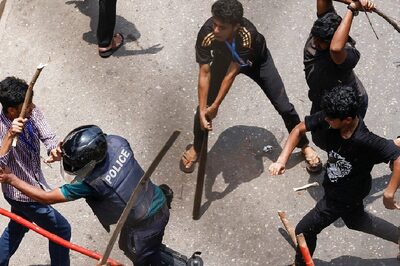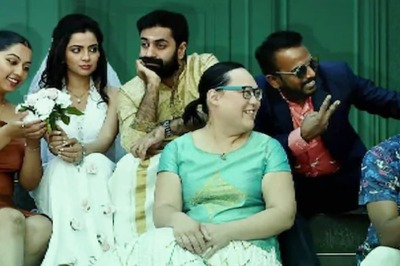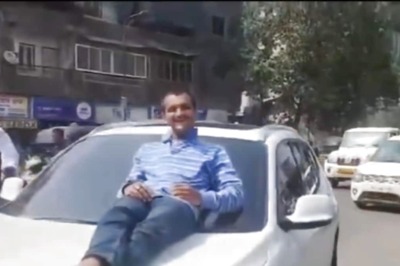
views
Patna: Nitish Kumar seems to have been caught in a bind over the deaths of over 160 children allegedly due to Acute Encephalitis Syndrome (AES) in Muzaffarpur district in north Bihar. Not only is the Bihar chief minister unable to explain the failure of the state health machinery in tackling the situation, he also faces simultaneous media and opposition onslaught, painting his otherwise good image in a bad light.
As he faces flaks for not handling the situation deftly, this arcane healthcare issue has all the potential to turn into a major and much messier political dispute between the Janata Dal-United (JDU) and the Bharatiya Janata Party (BJP) in the days to come.
Even otherwise, the JDU-BJP alliance hangs by a thread after Nitish’s refusal to join the Narendra Modi 2.0 government. The recent attack on Nitish by senior BJP leader and former union health minister, C P Thakur, is an indication that the relationship may be further strained if efforts are not made to reinforce it forthwith.
Thakur, a renowned physician himself, raised questions over the inability of the Nitish Kumar government to respond with medical assistance in time and to check the situation from getting worse every day. Thakur observed that the Bihar government gets active only at the time of the outbreak every year and no action is taken beforehand to prevent the occurrence of the deadly disease.
The BJP MP said that Bihar government should take the AES seriously and focus on research and high-level investigation to find out if the outbreak of the disease has anything to take with the consumption of litchis – the luscious fruit grown in and around Muzaffarpur.
Many BJP senior leaders have not publicly spoken against the Nitish Kumar government since the BJP is part of it and its health minister is BJP leader Mangal Pandey, who was on a tour to Canada when the disease broke out. But the blame-game between top leaders of the JDU and the BJP continues and the growing attacks on Nitish are being viewed as an upshot of the BJP machinations to put him in a tight spot.
The opposition Rashtriya Janata Dal (RJD), too, has attacked the Bihar government for its alleged failure to save the lives of children. Former chief minister Rabri Devi, senior RJD leader Raghuvansh Prasad Singh, Shivanand Tiwari and Tej Pratap Yadav have scathingly attacked both the state and central governments. Raghuvansh Singh has even demanded Nitish’s resignation on moral grounds.
However, the absence of Tejashwi Prasad Yadav from Bihar has earned the wrath of some people so much that they have put up a poster in Muzaffarpur announcing a cash reward of Rs 5,100 for anyone who finds or has information about his whereabouts. It claims that Tejashwi has been missing since the 2019 Lok Sabha results.
In the fast-changing contours of politics, JDU national president Nitish is seemingly undergoing a phase of unique dilemma. He is feeling uncomfortable in BJP’s company but is compelled to run the government with its support in Bihar. Officially, the JDU has announced that it is very much a part of the NDA at the Centre as well as in Bihar, and will fight the next assembly elections in 2020 in Bihar under the NDA banner.
At the same time, Nitish wants to come back to power in 2020 without the help of BJP but appears to be in a fix over how and whom to rope in to make a perfect winning coalition. Speculations about Nitish joining hands with the Congress or return to the RJD fold or form a separate coalition have been doing the rounds in political circles ever since he spurned the single-berth offer in the union council of ministers.
The Bihar chief minister had to face a hostile crowd when he visited Muzaffarpur 17 days later to take stock of the health facilities being provided to the affected children. People shouted slogans like ‘Nitish Kumar, go back’ to vent their anger over him visiting the hospital after the number of casualties crossed the three-digit mark. This incident is being viewed as a fallout of the increasing chasm between the BJP and the JDU.
As Muzaffarpur continues to grapple with the AES deaths, Nitish has maintained a studied silence on the government’s alleged failure and persons responsible for negligence even though media persons have literally hounded him in Delhi and Bihar. Even BJP leaders like Sushil Kumar Modi have refrained from making any comment on the deaths and the fixing of responsibility.
On his part, the chief minister has held a review meeting with health officials and announced to convert the 610-bed government hospital at Muzaffarpur into 2500-bed hospital and construct a dharamshala for families of the AES patients.
He has also instructed the officials to prepare a report on the condition of the families of the AES-inflicted children so that an action plan is prepared to check the menace in future. The economic and hygienic conditions will also be taken into account during the preparation of the report.
Amid hullabaloo, it remains a fact that this disease has been claiming lives of children for the past over a decade in this particular region during mid-May to mid-June every year. There has been a pattern in outbreak of the killer disease and the socio-economic background of the victim children.
But every time the disease broke out in the past, the government took some face-saving measures and when the menace ended after arrival of monsoon, it forgot to take steps that could have checked recurrence of the disease next year. The government did not keep the local hospitals in readiness at this time of the season to keep the casualty low.
Since the timing of outbreak of AES is almost fixed, the government should have come up with a comprehensive action plan to tackle it and save the lives of hundreds of children. The state, as well as the central government, should have taken curative advice from the World Health Organisation (WHO) or medical institutions of repute in India or abroad to find a lasting solution to the problem.
When the disease was detected and found to be affecting kids and toddlers during the initial years, the state and Centre had blamed it on the litchi fruit. But the powerful litchi lobby of big farmers of this region objected to it, apprehending that their traditional business will be badly hit.
(The author is a senior journalist. Views expressed are personal.)




















Comments
0 comment